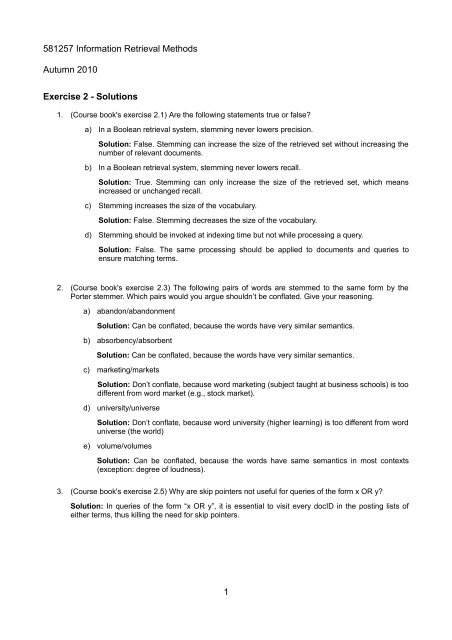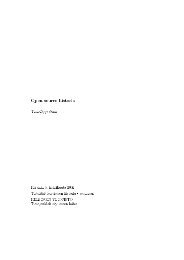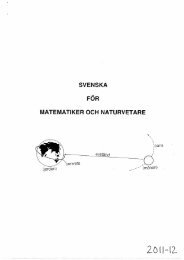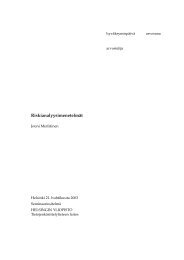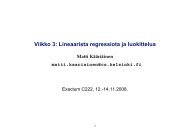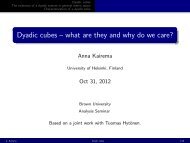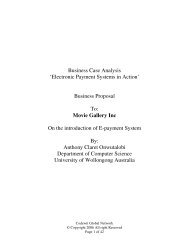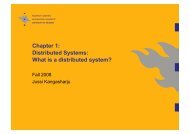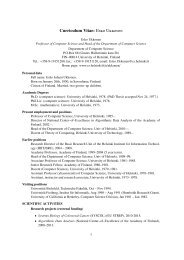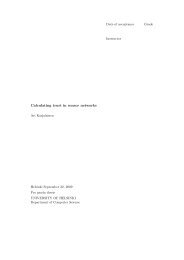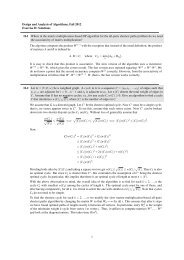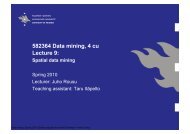581257 Information Retrieval Methods Autumn 2010 Exercise 2 ...
581257 Information Retrieval Methods Autumn 2010 Exercise 2 ...
581257 Information Retrieval Methods Autumn 2010 Exercise 2 ...
You also want an ePaper? Increase the reach of your titles
YUMPU automatically turns print PDFs into web optimized ePapers that Google loves.
<strong>581257</strong> <strong>Information</strong> <strong>Retrieval</strong> <strong>Methods</strong><br />
<strong>Autumn</strong> <strong>2010</strong><br />
<strong>Exercise</strong> 2 - Solutions<br />
1. (Course book's exercise 2.1) Are the following statements true or false?<br />
a) In a Boolean retrieval system, stemming never lowers precision.<br />
Solution: False. Stemming can increase the size of the retrieved set without increasing the<br />
number of relevant documents.<br />
b) In a Boolean retrieval system, stemming never lowers recall.<br />
Solution: True. Stemming can only increase the size of the retrieved set, which means<br />
increased or unchanged recall.<br />
c) Stemming increases the size of the vocabulary.<br />
Solution: False. Stemming decreases the size of the vocabulary.<br />
d) Stemming should be invoked at indexing time but not while processing a query.<br />
Solution: False. The same processing should be applied to documents and queries to<br />
ensure matching terms.<br />
2. (Course book's exercise 2.3) The following pairs of words are stemmed to the same form by the<br />
Porter stemmer. Which pairs would you argue shouldn’t be conflated. Give your reasoning.<br />
a) abandon/abandonment<br />
Solution: Can be conflated, because the words have very similar semantics.<br />
b) absorbency/absorbent<br />
Solution: Can be conflated, because the words have very similar semantics.<br />
c) marketing/markets<br />
Solution: Don’t conflate, because word marketing (subject taught at business schools) is too<br />
different from word market (e.g., stock market).<br />
d) university/universe<br />
Solution: Don’t conflate, because word university (higher learning) is too different from word<br />
universe (the world)<br />
e) volume/volumes<br />
Solution: Can be conflated, because the words have same semantics in most contexts<br />
(exception: degree of loudness).<br />
3. (Course book's exercise 2.5) Why are skip pointers not useful for queries of the form x OR y?<br />
Solution: In queries of the form “x OR y”, it is essential to visit every docID in the posting lists of<br />
either terms, thus killing the need for skip pointers.<br />
1
4. (Course book's exercise 2.7) Consider a postings intersection between this postings list, with skip<br />
pointers:<br />
and the following intermediate result postings list (which hence has no skip pointers):<br />
Trace through the postings intersection algorithm in Figure 2.10 (page 37).<br />
a) How often is a skip pointer followed (i.e., p1 is advanced to skip(p2))?<br />
Solution: The skip pointer is followed once (from 24 to 75).<br />
b) How many postings comparisons will be made by this algorithm while intersecting the two<br />
lists?<br />
Solution: 19 comparisons are made. Let (x,y) denote a posting comparison. The<br />
comparisons are: (3,3), (5,5), (9,89), (15,89), (24,89), (75,89), (75,89), (92,89), (81,89),<br />
(84,89), (89,89), (92,95), (115,95), (96,95), (96,97), (97,97), (100,99), (100,100), (115,101).<br />
c) How many postings comparisons would be made if the postings lists are intersected without<br />
the use of skip pointers?<br />
Solution: 19 comparisons are made. The comparisons are: (3,3), (5,5), (9,89), (15,89),<br />
(24,89), (39,89), (60,89), (68,89), (75,89), (81,89), (84,89), (89,89), (92,95), (96,95), (96,97),<br />
(97,97), (100,99), (100,100), (115,101).<br />
5. (Course book's exercise 2.6) We have a two-word query. For one term the postings list consists of<br />
the following 16 entries:<br />
[4,6,10,12,14,16,18,20,22,32,47,81,120,122,157,180]<br />
and for the other it is the one entry postings list:<br />
[47]<br />
Work out how many comparisons would be done to intersect the two postings lists with the following<br />
two strategies. Briefly justify your answers:<br />
a) Using standard postings lists<br />
Solution: Applying MERGE on the standard postings list, comparisons will be made<br />
unless either of the postings list end, i.e., till we reach 47 in the upper postings list, after<br />
which the lower list ends and no more processing needs to be done. Therefore, the<br />
number of comparisons made is 11.<br />
b) Using postings lists stored with skip pointers, with a skip length of √P, as suggested in<br />
Section 2.3<br />
Solution: Using skip pointers of length 4 for the longer list and of length 1 for the shorter<br />
list, the following comparisons will be made: (4,47), (14,47), (22,47), (120,47), (22,47),<br />
(120,47), (32,47), (47,47). Therefore, the number of comparisons made in this case is 8.<br />
This is not, however, an optimal approach, because comparisons (22,47) and (120,47)<br />
are made two times. The solution would be more optimal, if we would add command “p 1<br />
← next(p1)” directly after the while loop. Then the number of comparisons would be<br />
decreased to 6.<br />
2
6. (Course book's exercise 2.9) Shown below is a portion of a positional index in the format: term: doc1:<br />
〈position1, position2, . . . 〉; doc2: 〈position1, position2, . . . 〉; etc.<br />
angels: 2: 〈36,174,252,651〉; 4: 〈12,22,102,432〉; 7: 〈17〉;<br />
fools: 2: 〈1,17,74,222〉; 4: 〈8,78,108,458〉; 7: 〈3,13,23,193〉;<br />
fear: 2: 〈87,704,722,901〉; 4: 〈13,43,113,433〉; 7: 〈18,328,528〉;<br />
in: 2: 〈3,37,76,444,851〉; 4: 〈10,20,110,470,500〉; 7: 〈5,15,25,195〉;<br />
rush: 2: 〈2,66,194,321,702〉; 4: 〈9,69,149,429,569〉; 7: 〈4,14,404〉;<br />
to: 2: 〈47,86,234,999〉; 4: 〈14,24,774,944〉; 7: 〈199,319,599,709〉;<br />
tread: 2: 〈57,94,333〉; 4: 〈15,35,155〉; 7: 〈20,320〉;<br />
where: 2: 〈67,124,393,1001〉; 4: 〈11,41,101,421,431〉; 7: 〈16,36,736〉;<br />
Which document(s) if any meet each of the following queries, where each expression within quotes<br />
is a phrase query?<br />
a) “fools rush in”<br />
Solution: All three documents (2, 4, and 7) satisfy the query. Documents 2 and 4 have one<br />
occurrence of the phrase and document 7 two occurrences.<br />
b) “fools rush in” AND “angels fear to tread”<br />
Solution: Only document 4 satisfy the query. Both the phrases occur once in the document.<br />
7. Solve the following exercises<br />
a) (Course book's exercise 3.1) In the permuterm index, each permuterm vocabulary term<br />
points to the original vocabulary term(s) from which it was derived. How many original<br />
vocabulary terms can there be in the postings list of a permuterm vocabulary term?<br />
Solution: One. If it weren’t for the $ terminal symbol, we could have multiple original<br />
vocabulary terms resulting from rotations of the same permuterm vocabulary term, e.g., leaf<br />
and flea.<br />
b) (Course book's exercise 3.2) Write down the entries in the permuterm index dictionary that<br />
are generated by the term mama.<br />
Solution: The entries are mama$, ama$m, ma$ma, a$mam and $mama.<br />
c) (Course book's exercise 3.3) If you wanted to search for s*ng in a permuterm wild-card<br />
index, what key(s) would one do the lookup on?<br />
Solution: The key to lookup on is ng$s*.<br />
3


